National Trauma Training Programme: workforce survey 2021
Main findings from an online survey of the Scottish workforce exploring awareness and attitudes to psychological trauma and trauma-informed practice. The survey was carried out by the Improvement Service as part of the National Trauma Training Programme.
3. Self-Assessed Confidence and Understanding
Overall Confidence and Understanding
3.1 Respondents were initially asked to assess their own understanding and confidence against a range of statements related to the concept and impact of trauma and of trauma-informed practice. The four statements are shown in the box below.
Self-Assessed Confidence Statements
1. Understanding of the concept of psychological trauma
2. Understanding of the impact of psychological trauma
3. Understanding of the principles of trauma-informed practice
4. Confidence in applying the principles of trauma-informed practice in your work
3.2 Respondents reported high levels of confidence in their understanding of the concept of psychological trauma, with 43.5% saying that they were very confident or extremely confident and just 13.8% saying that they were not so confident or not at all confident. A higher proportion, 45.7%, reported that they were very or extremely confident in their understanding of the impact of psychological trauma, with 14.8% describing themselves as not so confident or not at all confident.
3.3 There were lower rates of confidence in response to two statements about understanding of and confidence in applying trauma-informed practice. A slightly higher proportion said that they were not at all confident or not so confident (32.7%) in understanding the principles of trauma-informed practice, than said they were very or extremely confident (30.7%). This was also true of respondents' confidence in applying the principles of trauma-informed practice in their work, with just 26.7% saying that they were very or extremely confident and 36.6% saying that they were not at all or not so confident. The breakdown of responses by statement is shown in Figure 3.
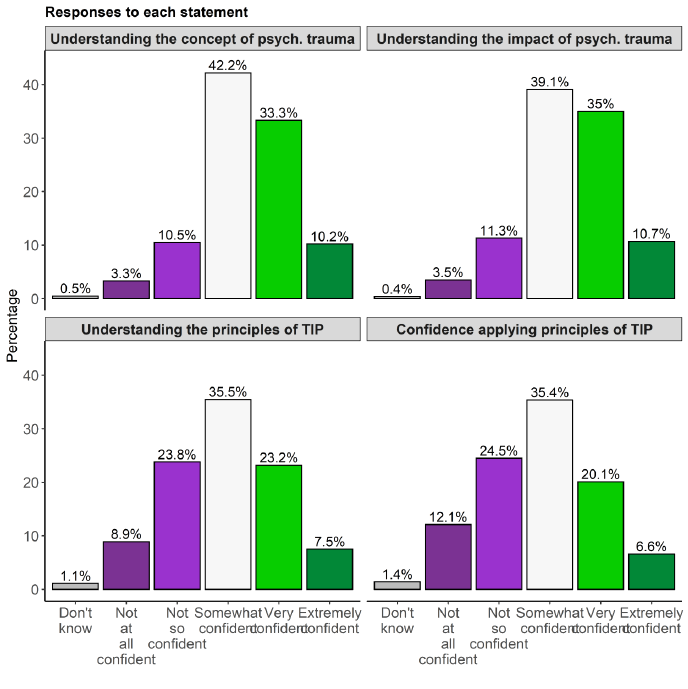
"I think this is an important part of our jobs and job role in the coming years. We are all coming out of a global pandemic that will have been traumatic for some people."
Confidence and Understanding by Sector, Service and Role
3.4 Analysis of the levels of confidence across sector area, service and job role in the responses to these four statements show significant differences between groups. Comparing responses by sector showed a higher level of confidence in response to all four statements among the third sector, with respondents in the public sector reporting lower levels of confidence across each of the statements.
3.5 These differences were particularly pronounced in responses to the statements on understanding and confidence in applying trauma-informed practice. In terms of understanding of the principles of trauma-informed practice, 41.6% of third sector respondents said that they were extremely or very confident while just 28.6% of public sector and 31% of private sector employees said the same. There was a similar disparity between third and public sector respondents in confidence in applying trauma-informed principles in their work. While 36.7% of third sector and 32.5% of private sector employees said that they were confident in response to this statement, just 24% of public sector employees felt confident and 40% said that they were not confident. The full breakdown by sector for each of these statements is displayed in Figure 4.
"I have seen many examples of individuals working in a trauma-informed way which has made a huge difference to children and young people. Most practitioners really understand this concept."
"This is an entirely new subject to me from a workplace perspective - it has never been discussed, except in the most general terms of Health and Safety and the potential consequences of serious accidents/incidents in the workplace."
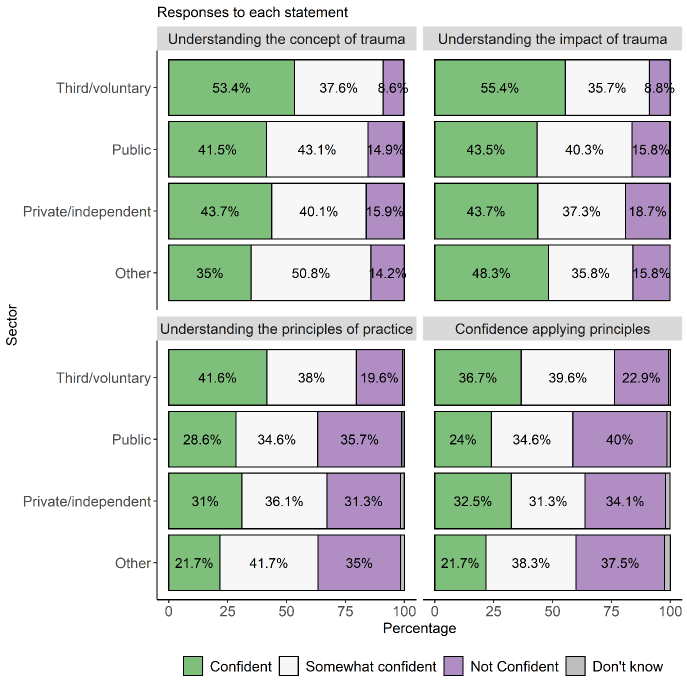
3.6 There were also large and statistically significant disparities in confidence levels between those working in different service areas, perhaps reflecting familiarity and perceived relevance of trauma-informed practice within day-to-day activities.
3.7 For the two statements around understanding of the concept and impact of psychological trauma, some service areas had very high levels of confidence. Those working in mental health and alcohol and drugs were statistically significantly more likely to say they were extremely or very confident in their understanding of the concept and impact of psychological trauma.
"I'd love to see more trauma-informed practice across the board. We are getting better at it in Education and Childcare, but attitudes are still very closed off across other sectors."
3.8 Those working in early years, physical health, economic development, finance and administration, and the "other" service area group were all below average in terms of confidence in understanding both the impact and concept of trauma, although this was only statistically significant for the last two service areas. The breakdown of confidence in response to the statements "understanding the concept of psychological trauma" and "understanding the impact of psychological trauma" are displayed in Figure 5.
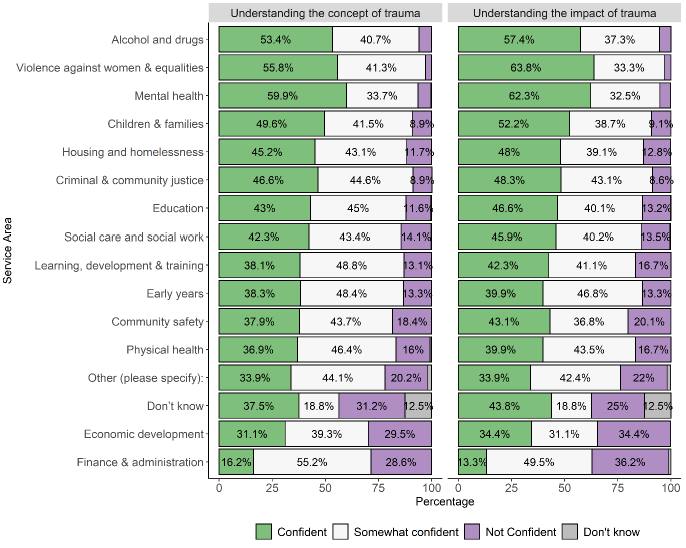
3.9 Respondents from a similar group of sectors also showed higher levels of confidence in understanding and applying the principles of trauma-informed practice in their work. As with the previous statements, employees working in mental health and alcohol and drugs were significantly more likely to report confidence in these areas. Figure 6 displays the breakdown in confidence in understanding and applying the principles of trauma-informed practice by service area.
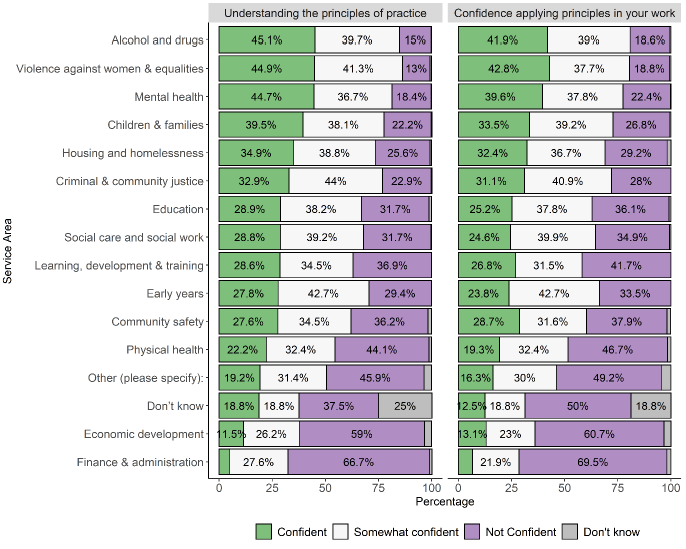
3.10 There were also differences in the levels of confidence based on job role and seniority. Across all four statements, senior management were more likely than any other group to say that they were extremely or very confident. Overall, however, there was little variation between job roles and their responses to the statements in question 5. The full breakdown by job role by statement is shown in Figure 7.
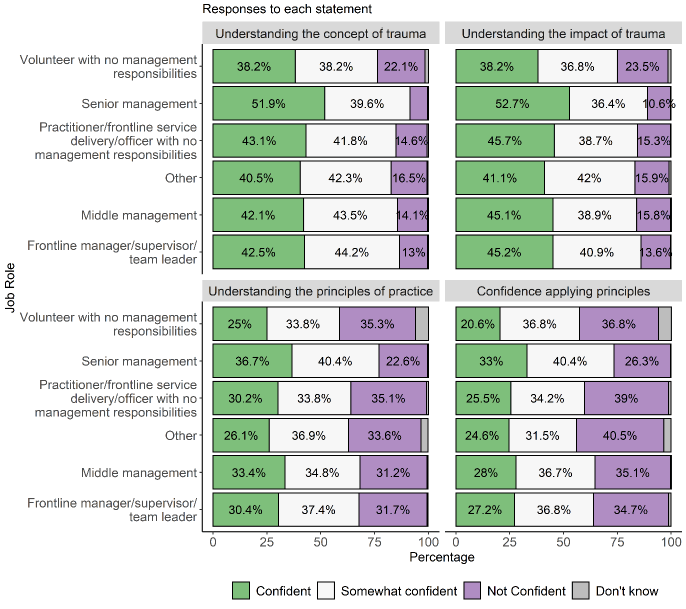
Contact
Email: ACEstrauma@gov.scot
There is a problem
Thanks for your feedback